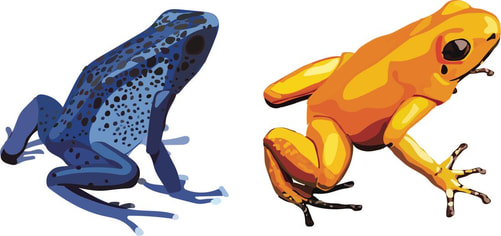Jack Dumbacher Lab
Official site of Jack Dumbacher's research, teaching, blog, and more...
Our Lab in the news...
7 November 2023
This wonderful new video highlights the work that we are doing in collaboration with Google Research teams: We've been working with Tom Denton, Lauren Harrell, and Matt Harvey (and others) at Google Research to build automated classifiers for audio recordings. The idea is that these can be used to turn sound recordings of the forest into functional surveys of birdlife that is present. This video explains how it works...
This wonderful new video highlights the work that we are doing in collaboration with Google Research teams: We've been working with Tom Denton, Lauren Harrell, and Matt Harvey (and others) at Google Research to build automated classifiers for audio recordings. The idea is that these can be used to turn sound recordings of the forest into functional surveys of birdlife that is present. This video explains how it works...
31 October 2023
Here is a super fun video with Adam Savage and the "Tested" team, discussing surface 3D scanning and CT scanning projects that we are working on in the CAS vertebrate collections (and see some CT scans of Darwins finches...)
Here is a super fun video with Adam Savage and the "Tested" team, discussing surface 3D scanning and CT scanning projects that we are working on in the CAS vertebrate collections (and see some CT scans of Darwins finches...)
New data on how poisonous Pitohui birds and Phyllobates dart-poison frogs resist their own toxins: We've been working on this for several years, and we had the best team of people imaginable! So nice to see this finally out...
- Abderemane-Ali, F., Rossen, N.D., Kobiela, M.E., Craig, R.A., Garrison, C.E., Chen, Z., Colleran, C.M., O'Connell, L.A., du Bois, J., Dumbacher, J.P., and Minor, D.L. (2021). Evidence that toxin resistance in poison birds and frogs is not rooted in sodium channel mutations and may rely on “ toxin sponge ” proteins. Journal of General Physiology 153, e202112872. Online and open access here: https://doi.org/10.1085/jgp.202112872
New HI-C genome assembly for the Northern Spotted Owl: With the addition of Hi-C reads from the Northern Spotted Owl, we have improved the assembly and scaffolding of the genome. Check out the blog here at the DNA-Zoo website. Also, statistics on the assembly and the full genome files are all accessible from this website: https://www.dnazoo.org/assemblies/Strix_occidentalis.
Rodenticide exposure in wildlife in public and private wild lands: Our paper on owl exposure to rodenticides is just out! The work, led by Mourad Gabriel, shows that rodenticides are getting into the food chain in wild lands, and affecting top avian predators like the federally-listed Northern Spotted Owl and the Barred Owl. The source? Illegal marijuana grows. As the demand for marijuana grows with legalization, the supply has not kept up, and the black market in cannabis is present and growing - some of which is being carried out illegally on public and private wild lands.
- Gabriel, M. W., L. V. Diller, J. P. Dumbacher, G. M. Wengert, J. M. Higley, R. H. Poppenga and S. Mendia. 2018. Exposure to rodenticides in Northern Spotted and Barred Owls on remote forest lands in northwestern California: evidence of food web contamination. Avian Conservation and Ecology 13 (1):2. [online] URL: http://www.ace-eco.org/vol13/iss1/art2/
The genome assemblies of the Northern Spotted Owl (Strix occidentalis caurina) are now online in Genome Biology and Evolution and PeerJ! Our first complete bird genome assembly, with mitochondrial assemblies (not trivial in this case!), and a great resource for Northern Spotted Owl conservation genetics! Way to go Zach Hanna (what an ambitious PhD project...!!!)
- Zachary R. Hanna,James B. Henderson, Anna B. Sellas, Jérôme Fuchs, Rauri C.K. Bowie, John P. Dumbacher. 2017. Complete mitochondrial genome sequences of the northern spotted owl (Strix occidentalis caurina) and the barred owl (Strix varia; Aves: Strigiformes: Strigidae) confirm the presence of a duplicated control region. PeerJ 5:e3901. https://doi.org/10.7717/peerj.3901
- Zachary R. Hanna, James B. Henderson, Jeffrey D. Wall, Christopher A. Emerling, Jérôme Fuchs Charles Runckel, David P. Mindell, Rauri C. K. Bowie, Joseph L. DeRisi, John P. Dumbacher. 2017. Northern spotted owl (Strix occidentalis caurina) genome: divergence with the barred owl (Strix varia) and characterization of light-associated genes. Genome Biology and Evolution evx158, https://doi.org/10.1093/gbe/evx158
- Zachary R. Hanna, James B. Henderson, Jeffrey D. Wall, Christopher A. Emerling, Jérôme Fuchs Charles Runckel, David P. Mindell, Rauri C. K. Bowie, Joseph L. DeRisi, John P. Dumbacher. 2017. Supplemental dataset for Northern Spotted Owl (Strix occidentalis caurina) genome assembly version 1.0. Zenodo. http://doi.org/10.5281/zenodo.822859. DOI:10.5281/zenodo.822859
Our work on giant sengi phylogeny is now online!
- Elizabeth J. Carlen, Galen B. Rathbun, Link E. Olson, Christopher A. Sabuni, William T. Stanley, and John P. Dumbacher.2017. Reconstructing the molecular phylogeny of giant sengis (Macroscelidea; Macroscelididae; Rhynchocyon). Molecular Phylogenetics and Evolution 113:150-160. http://dx.doi.org/10.1016/j.ympev.2017.05.012.
Check out the publication by Ethan Linck on using HyRAD sequencing for "ancient" DNA from museum skins, looking at New Guinean Yellow-billed Kingfishers and Mountain Kingfishers:
- Linck EB, Hanna ZR, Sellas A, Dumbacher JP. 2017. Evaluating hybridization capture with RAD probes as a tool for museum genomics with historical bird specimens. Ecology and Evolution. 2017;00:1–13. https://doi.org/10.1002/ece3.3065
Check out our publication on avian Viruses from Maxine Zylberberg and colleagues in Joe Derisi's lab:
- M. Zylberberg, C. Van Hemert, J. P. Dumbacher, C. M. Handel, T. Tihand, J. L. DeRisi. 2016. Novel picornavirus associated with avian keratin disorder in Alaskan birds. doi: 10.1128/mBio.00874-16 26 July 2016 mBio vol. 7 no. 4e00874-16.
Check out our publication on the Vermilion Flycatcher - a phylogeny of the entire species complex, and evidence for unrecognized (and probably now extinct!) forms in Galapagos!
- O. Carmi, C. C. Witt, A. Jaramillo, and J. P. Dumbacher. 2016. Phylogeography of the Vermilion Flycatcher species complex: Multiple speciation events, shifts in migratory behavior, and an apparent extinction of a Galápagos-endemic bird species. Molecular Phylogenetics and Evolution 102 (2016) 152-173.






